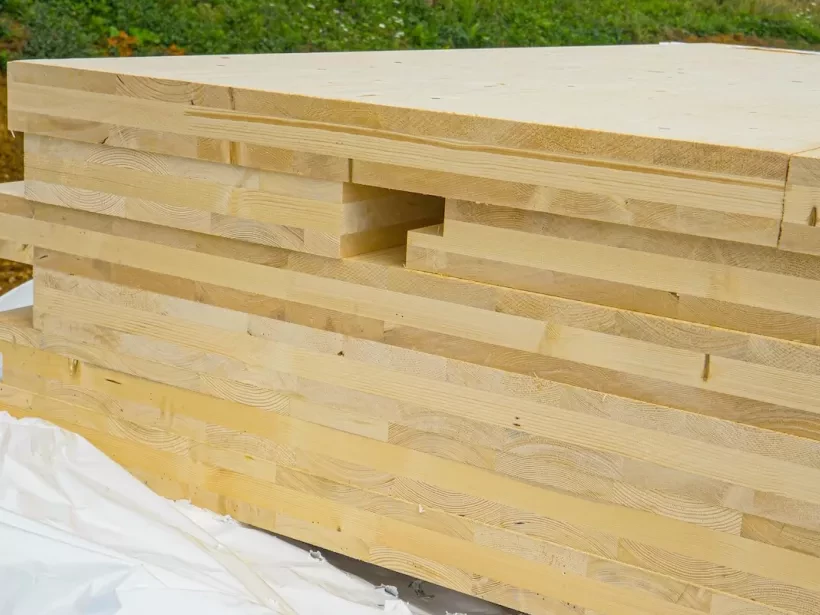Cross-laminated timber (CLT): Benefits, uses, and logistics

Cross-laminated timber, or CLT, is becoming one of the most in-demand building materials in the construction industry. The global CLT market size is expected to grow from USD 1.5 billion in 2024 to USD 3.5 billion by 2030.
From single-family homes to office buildings, sports arenas, and even skyscrapers, cross-laminated timber is gaining momentum thanks to its strength, low carbon footprint, and design flexibility.
Read on to find out how cross-laminated timber is made, where it’s most commonly used, and how to properly handle and transport CLT panels.
What is cross-laminated timber (CLT)?
Cross-laminated timber is a type of engineered wood panel that’s made by stacking several layers of solid-sawn lumber (at least three). Each layer is placed at a right angle to the one below, and they’re bonded with strong adhesives.
Gluing layers of wood at 90° angles gives the CLT panels strong structural rigidity in both directions.
What is CLT made from?
Cross-laminated timber is usually made from softwoods such as pine, spruce, or fir. Some manufacturers also experiment with hardwoods like oak and beech for added strength.
Softwoods are generally preferred due to their wide availability, high strength-to-weight ratio, dimensional stability, and cost-effectiveness.
How is cross-laminated timber made?
A standard manufacturing facility makes CLT panels in seven steps:
- Lumber selection. Manufacturers grade wood boards for strength and quality, minimizing large knots or splits.
- Drying and planing. The boards are then kiln-dried to reduce moisture, prevent warping, and ensure good bonding. After drying, manufacturers plane the boards for a tight fit.
- Finger-jointing (optional). Shorter boards are often glued end-to-end with interlocking cuts to create long, continuous layers. This helps produce large panels without weak points.
- Panel lay-up. The boards are laid out side by side to form a single layer. Every new layer is placed on top perpendicular to the one below it.
- Adhesive application. A thin layer of structural adhesive is applied between each layer of boards. Manufacturers primarily use polyurethane adhesives to create a strong bond between the wood layers.
- Assembly pressing. The stacked and glued layers are pressed together with either a hydraulic press or a vacuum press.
- Cutting and finishing. Once cured, the CLT panels are cut to size using CNC machines. Manufacturers can pre-cut openings for windows, doors, stairs, and service channels.

CLT panels vs. other engineered wood
CLT stands out among mass timber products thanks to its strength and stability.
With the timber layers glued together crosswise, CLT is perfect for large structural panels like walls, floors, ceilings, and roofs.
| Engineered wood | Made from | Main uses | Key difference |
| CLT | Solid timber boards, layers glued crosswise | Walls, floors, roofs, multi-story buildings | Strong in two directions; large panels for structural use |
| Glued laminated timber (glulam) | Boards glued with grains in same direction | Beams, columns, arches | Strength mainly along grain; used for long beams, not large panels |
| Laminated veneer lumber (LVL) | Thin veneers glued parallel | Beams, headers | Similar to glulam; good for load-bearing beams but not panels |
| Plywood | Thin veneers glued in alternating grains | Sheathing, furniture | Smaller sheets; less structural strength than CLT |
| Oriented strand board (OSB) | Wood strands pressed and glued | Subfloors, walls, roof sheathing | Cheaper, lighter; not for exposed structural panels |
Benefits of cross-laminated timber
Cross-laminated timber offers a range of advantages that make it a top choice for modern construction. From performance and sustainability to speed and design freedom, CLT products help architects and builders create strong, efficient, and eco-friendly buildings.
Here are some of the main benefits of CLT panels:
- Strength and stability. The cross-laminated layers give CLT panels excellent structural strength while resisting warping, twisting, and shrinking over time. This makes them ideal for walls, floors, and roofs in a variety of projects.
- Lighter weight. CLT structures are up to five times lighter than concrete and steel equivalents, reducing foundation loads and simplifying transportation and installation.
- Fast construction. Prefabricated CLT panels arrive ready to be installed, allowing builders to assemble structures quickly and efficiently, saving time and labor expenses on site.
- Fire resistance. The outer layers of CLT char when exposed to fire, providing additional fire protection that helps maintain structural integrity.
- Thermal and acoustic performance. Cross-laminated timber naturally insulates against heat and dampens noise, creating comfortable indoor environments without extra layers of insulation.
- Sustainable material. CLT stores carbon and has a lower environmental footprint than cement, steel, and other materials. It can also contribute to green building certifications such as LEED or BREEAM.
- Creative building design. CLT offers design flexibility, as large panels and precise cutting enable architects to explore creative layouts and modern architectural designs.
With its mix of strength, speed, and sustainability, CLT is redefining how buildings are designed and constructed.

Applications of cross-laminated timber
Thanks to its strength, dimensional stability, and lightweight nature, CLT is highly versatile and used across a wide range of construction projects.
From homes and offices to mid-rise buildings and sports facilities, cross-laminated timber offers a durable, eco-friendly, and efficient building solution.
Residential buildings
Cross-laminated timber is perfect for single-family homes, townhouses, and multi-story apartment blocks. CLT panels can be used for walls, floors, and roofs, often replacing concrete and masonry.
Commercial buildings
Offices, hotels, and retail spaces benefit from CLT’s speed of installation, precision, and clean finishes. Cross-laminated timber makes it easy to meet modern architectural standards.
Public buildings
Libraries, cultural centers, and sports facilities use CLT for its structural reliability, large-span capabilities, and natural aesthetic appeal. CLT structures with exposed timber add warmth and character to interiors.
Industrial buildings
Warehouses and workshops benefit from CLT’s lightweight panels, quick construction, and flexibility in layout.
Cross-laminated timber is also popular in mid-rise and modular construction, where it can be combined with concrete or steel in hybrid structures. This enables achieving greater heights or specialized designs.
CLT’s adaptability enables architects to create innovative layouts, large open spaces, and sustainable buildings with a reduced carbon footprint.
Shipping and handling cross-laminated timber
Cross-laminated timber (CLT) panels are large, heavy, and often prefabricated to exact dimensions. They are usually transported by flatbed trucks, trailers, open rail wagons, or containers.
Proper shipping and handling are essential to prevent damage and ensure panels arrive ready for fast, precise installation.
Key factors to consider when transporting CLT
- Panel size and weight. Ensure transport vehicles and loading equipment are rated for the panel dimensions and weight.
- Support during transportation. Stack CLT panels flat and provide even support to prevent bending, warping, or cracking.
- Weather protection. Wrap or cover panels to prevent them from prolonged exposure to moisture that can lead to swelling or deformation.
- Loading and placement. Use appropriate techniques and equipment to avoid structural damage. Automated loading solutions can improve safety and efficiency.
- Protect edges and corners. Use guards or padding to shield vulnerable panel edges and corners from impact.
Careful handling and shipping help maintain CLT’s quality, safety, and performance from the manufacturing facility to the construction site.

Loading and unloading CLT panels
The loading and unloading process carries the highest risk of damage to panels and safety hazards for workers.
Using incorrect rigging points, uneven straps, or inadequate lifting equipment can bend or crack a panel. CLT panels stacked without spacers or secure positioning might shift, tilt, or collapse during handling.
Automation can reduce both product damage and safety risks. For projects handling large volumes of cross-laminated timber, the Container Loading System helps speed up the process while ensuring panels remain secure and intact.

Why use cross-laminated timber?
CLT combines strength with lighter weight, making it a practical alternative to more traditional materials. Its high strength-to-weight ratio allows for multi-story construction while keeping the overall structure easier to transport and assemble.
Cross-laminated timber also speeds up construction. Prefabricated panels arrive ready to install, reducing build times, labor requirements, and on-site disruption.
From an environmental perspective, CLT stands out. It’s made from renewable wood and helps reduce the overall carbon footprint of a building project. At the same time, it offers architects and builders flexibility to create efficient, modern, and visually appealing designs.
FAQ: Cross-laminated timber (CLT)
How strong is cross-laminated timber (CLT) compared to concrete or steel?
Steel and concrete still outperform CLT for extremely heavy loads or very tall structures, but CLT offers more than enough strength for most residential, commercial, and mid-rise projects.
Is CLT safe in a fire?
CLT has significant fire resistance on its own, but in some cases a protective layer such as gypsum board is added before construction to meet building code requirements.


